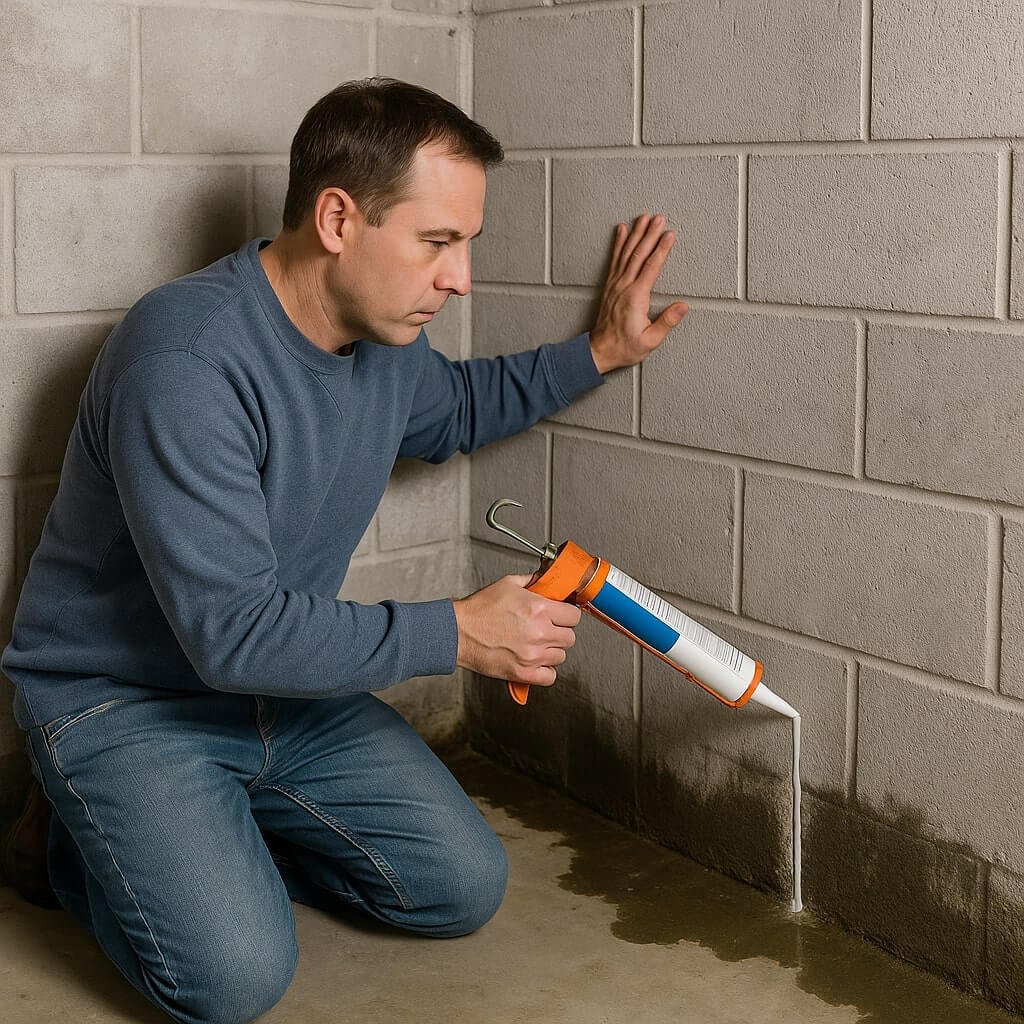Waterproofing your basement walls is vital for preventing moisture issues that can lead to costly damage. You’ll need to identify any signs of water damage and prepare the area appropriately before applying any solutions. Choosing the right waterproofing method is essential, as it impacts the effectiveness of your efforts. In the following sections, we’ll explore various techniques and materials to guarantee your basement stays dry and protected.
Key Takeaways
- Assess and repair any existing water damage and structural issues before starting the waterproofing process.
- Clear the basement of clutter for easy access to walls and floors during waterproofing.
- Choose appropriate waterproofing materials like sealants or coatings based on moisture levels and wall conditions.
- Thoroughly clean walls to remove dirt and mold prior to applying waterproofing solutions.
- Regularly maintain ventilation and humidity levels to prevent future water issues in the basement.
Understanding the Importance of Waterproofing
When you think about your home’s structural integrity, waterproofing basement walls should be a top priority.
By implementing proper waterproofing, you’re ensuring moisture prevention, which protects your foundation from water damage and mold growth. The waterproofing benefits extend beyond structural safety; it also enhances air quality and increases your home’s value.
You’ll reduce the risk of costly repairs associated with water intrusion. Investing in effective waterproofing solutions like sealants or drainage systems can provide long-term protection.
Don’t overlook this essential aspect of home maintenance, as a dry basement contributes to overall comfort and safety in your living space.
Identifying Signs of Water Damage

When you inspect your basement, look for visible mold growth, which often appears in dark patches on walls or ceilings.
You should also pay attention to any damp or musty odors, as these can indicate trapped moisture and potential water damage.
Identifying these signs early is essential for preventing further issues and ensuring a safe, dry environment.
Visible Mold Growth
Mold growth often signals underlying water damage in your basement, and spotting it early can save you from more extensive repairs.
Look for visible patches or discoloration on walls and ceilings, especially in corners and around windows. These areas are often damp due to poor humidity control.
To combat this, maintain your basement’s humidity levels below 60% using dehumidifiers and proper ventilation.
Implement mold prevention techniques, such as sealing cracks and ensuring proper drainage outside.
Regularly inspect your basement for any signs of moisture, as early identification is essential to preventing mold proliferation and preserving your home’s integrity.
Damp or Musty Odors
If you notice damp or musty odors lingering in your basement, it’s a clear indication of potential water damage.
These smells often arise from moisture buildup, which can lead to mold growth and structural issues. Check for leaks in pipes, cracks in walls, or condensation on surfaces.
Additionally, consider the ventilation; poor airflow exacerbates damp odors. You should also inspect any stored items, as they may harbor mold or mildew.
Addressing the source of these musty smells promptly is essential to prevent further damage and maintain a healthy living environment.
Be proactive to keep your basement dry and odor-free.
Preparing Your Basement for Waterproofing
Before you start waterproofing, assess any existing water damage in your basement to understand the extent of the problem.
Clear away clutter to guarantee easy access to walls and floors, making it simpler to inspect for cracks or signs of moisture.
This preparation lays the groundwork for effective waterproofing solutions.
Assess Existing Water Damage
How can you guarantee your basement is truly ready for waterproofing? Start with a thorough water damage assessment.
Look for visible signs like stains, mold, or peeling paint. Use a moisture measurement tool to detect hidden issues in the walls and floor.
Check corners and joints, as they’re often susceptible to leaks. Document your findings, noting areas with high moisture levels, as this will guide your waterproofing strategy.
If you find extensive damage, you might need to address structural issues before proceeding. Understanding the extent of the water damage is vital to guarantee effective waterproofing and long-term protection for your basement.
Clear Basement Clutter
Clearing basement clutter is essential for effective waterproofing. A well-organized space allows you to identify problem areas and guarantees you can properly apply waterproofing solutions.
Implement these decluttering strategies for ideal basement organization:
- Sort items into keep, donate, or discard categories
- Use stackable bins for efficient storage
- Label everything clearly for easy access
- Create designated zones for different types of items
- Regularly reassess and maintain order
Inspect Walls and Floors
Inspecting your basement walls and floors is an essential step in the waterproofing process.
Begin by checking the wall materials for cracks, gaps, or signs of deterioration. Pay close attention to corners and seams, as these are common moisture entry points.
Use a moisture meter to measure moisture levels in both walls and floors; this will help you identify areas needing immediate attention.
If you find excessive moisture, consider applying a sealant or hiring a professional for repairs.
Choosing the Right Waterproofing Method
When you’re faced with the challenge of waterproofing basement walls, selecting the right method is essential for long-term effectiveness.
Consider these factors to make an informed decision:
- Cost considerations: Evaluate your budget for both materials and labor.
- Waterproofing materials: Research options like sealants, membranes, or coatings.
- Wall condition: Assess any cracks or damage before choosing a method.
- Moisture level: Determine how much water intrusion your basement experiences.
- Installation complexity: Some methods require professional assistance, while others are DIY-friendly.
Applying Interior Waterproofing Solutions
After choosing the right waterproofing method for your basement, it’s time to focus on applying interior waterproofing solutions.
Start by cleaning the walls thoroughly to remove dirt and mold. Once dry, use interior sealants to fill cracks and gaps, ensuring a solid barrier against moisture.
For broader coverage, apply waterproof coatings over the entire surface using a roller or brush. Make sure to follow the manufacturer’s instructions for application thickness and drying times.
This will create a resilient, moisture-resistant layer that protects your basement walls from leaks and dampness, enhancing the overall integrity of your home.
Installing Exterior Waterproofing Systems

To effectively protect your basement from water intrusion, installing exterior waterproofing systems is crucial. Start by employing proper excavation techniques to expose the foundation walls. This allows for the application of effective drainage systems, preventing water buildup.
Here are key components to take into account:
- Waterproof membranes: Install these on foundation walls to block moisture.
- Drainage tiles: Position around the perimeter to redirect water.
- Grading: Guarantee soil slopes away from the foundation.
- Sump pumps: Think about installing for additional water removal.
- Backfill: Use clean gravel for ideal drainage and support.
Following these steps guarantees long-lasting protection against water damage.
Sealing Cracks and Joints
Even with a robust exterior waterproofing system in place, water can still find its way into your basement through cracks and joints in the foundation. To prevent this, you need effective crack sealing and joint reinforcement techniques. Start by inspecting your walls for visible cracks. Use a suitable epoxy or polyurethane sealant to fill these gaps. For joints, consider adding reinforcement materials like foam or rubber gaskets to enhance water resistance. The table below summarizes key methods for sealing:
| Method | Material | Application |
|---|---|---|
| Crack Sealing | Epoxy | Fill visible cracks |
| Joint Reinforcement | Foam Gaskets | Seal joint edges |
| Flexible Sealant | Polyurethane | Moveable joints |
| Hydraulic Cement | Cement-based | Bulk cracks |
| Silicone Sealant | Silicone | Non-structural cracks |
Maintaining a Dry Basement Environment
Maintaining a dry basement environment is essential for preventing mold growth and structural damage, especially since moisture can quickly accumulate in this often-overlooked area of your home.
A dry basement is crucial for avoiding mold and structural damage, as moisture can easily build up in this neglected space.
To achieve effective basement ventilation and humidity control, consider these significant steps:
- Install exhaust fans to promote air circulation.
- Use a dehumidifier to maintain ideal humidity levels (30-50%).
- Seal windows and vents to prevent outside moisture ingress.
- Regularly inspect and clean gutters to direct water away.
- Monitor humidity levels with a hygrometer to guarantee proper upkeep.
When to Call a Professional Waterproofing Service
If you’ve noticed persistent dampness, mold growth, or water seepage in your basement, it may be time to contemplate calling a professional waterproofing service.
Knowing when to hire experts is essential. If DIY methods haven’t resolved the issue or if the damage seems extensive, it’s wise to seek a professional assessment.
Look for signs like cracked walls, consistent musty odors, or water pooling. These indicate underlying problems that require specialized tools and knowledge.
Professionals can identify the root cause, recommend appropriate solutions, and guarantee proper installation, giving you peace of mind and a truly waterproofed basement.
Conclusion
By taking the right steps to waterproof your basement, you can effectively prevent water damage and create a healthier living space. Regularly inspect your walls for signs of moisture, and maintain a proactive approach to sealing cracks and joints. Whether you choose to apply interior solutions or install exterior systems, following proper techniques is vital. If you encounter significant issues or feel overwhelmed, don’t hesitate to call a professional waterproofing service for expert assistance.




